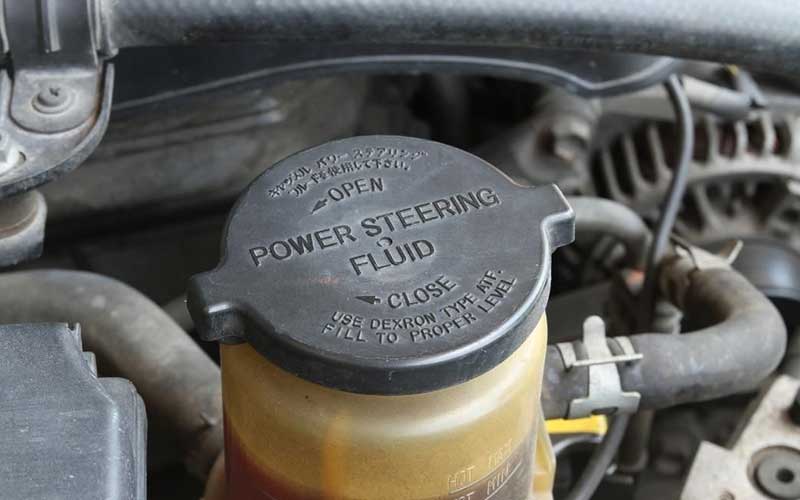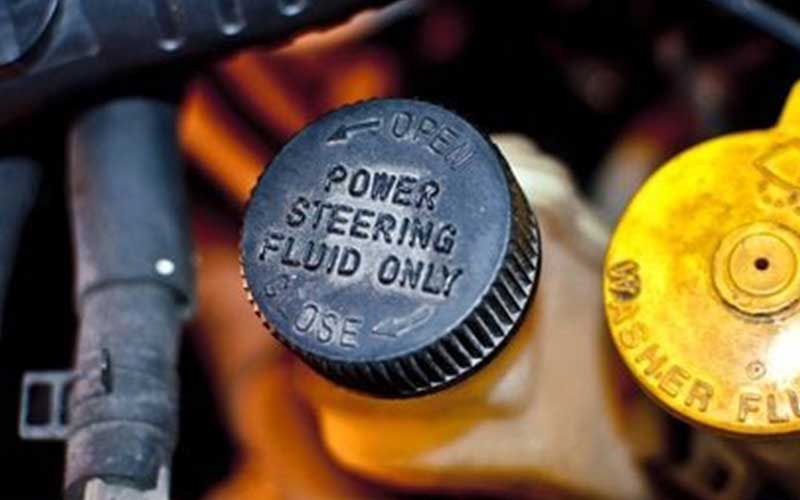What power steering fluid color is the best? What are the different permissible colors for power steering fluid, and what is their significance? It might be challenging to distinguish power steering fluids because they come in so many different colorings.
Here is a helpful guideline that will let you know about these different colors.
To guarantee that every system in your automobile gets the necessary level of lubrication, your vehicle uses various fluid types, including power steering. If something is leaking under the automobile, it is mostly fluid, making it harder to pinpoint the source of the leak.
This article will look at the many shades of power steering fluid, potential leaks, the fundamentals of the fluid, and the different types of fluid.
What Is Power Steering Fluid?
The steering mechanism uses a power steering fluid. As a result, the steering and front wheels are connected hydraulically. The effort required to move the wheels is lessened because of this fluid. In turn, this makes it easy for the driver to turn & control the vehicle.
The fluid lubricates the steering system’s moving elements, including the following: Power steering pump, Hoses, Valves, Pistons, etc.
For older vehicles with hydraulic steering systems, automatic transmission fluid serves a similar purpose. Power steering fluid is also utilized in more recent automobiles with electrical steering systems, particularly in heavy-duty trucks and heavy-diesel vehicles.
Also Read: Can You Use Power Steering Fluid as Brake Fluid?
Components of Power Steering Fluid
Petroleum, mineral oil, or silicone are often used in the production of power steering fluid, along with a few additives. Some liquids are produced using oil with a synthetic base. The components of the fluid may change. There are many different types of power steering fluids, as a result, it depends on the manufacturer’s choice or market demand.
What Are The Power Steering Fluid Colors

It’s important to know what colors the power steering fluids in vehicles are. Your automobile contains a lot of fluids, some of which include the coolant, braking fluid, steering fluid, transmission fluid, and engine oil.
You would only be capable of identifying a liquid if you knew its color as you see it seeping down your vehicle. You should be capable of determining what is malfunctioning in your vehicle by identifying the fluid color because different fluids are colored differently. Below are the different fluid colors.
Clear
While the power steering fluid typically has a pink or red tint, you must realize that this is as a result of the dye. The liquid is originally transparent. Some companies make sure it’s unaltered because they think that dyeing the liquid would alter its chemical makeup. It is, therefore, likely that the steering fluid is clear.
Red or Pink
The color of the power steering fluid is often red or pink. Red dye is commonly used in power steering fluid, while Some people have a stronger affinity for pink.
It’s likely that the power steering fluid is leaking if you detect a crimson liquid coming from the vehicle. In order to be sure, you can check the leak’s location. It’s likely the power steering fluid if the leak is coming from the front of the vehicle, a bit close to the driver’s seat.
The power steering fluid is a little bit slick, although the texture won’t reveal anything about that. Many additional fluids in the vehicle are like this because they help to reduce friction.
What does it signify if your driveway has pink or red fluid? You must address the problem right away if there’s leakage. The best part is that it’s working correctly and has not expired.
Yellow Power Steering Fluid
It’s not necessarily unclean if the power steering liquid is yellow. Then why did the fluid change color to yellow? The possibility of coolant and power steering fluid mixing is most likely the cause.
Actually, it won’t have a big impact on the power steering. The power steering system won’t be adversely affected until the ratio of coolant to power steering fluid substantially alters in the coolant’s direction. However, if the coolant leaks, you risk running out of oil. Therefore, you need to fix it.
Dark Brown Or Black
Black or dark brown steering fluid is not a color that is made. The engine oil is designated with this color. Initially, engine oil is a dark liquid. It turns black when it gathers debris and dust from inside your engine.
In steering fluid, the same is evident. Even if you fill the reservoirs with red-colored fluid, after some time, they will be filled with debris and dirt. The fluid gradually turns black or brown as a result of this.
Replace the fluid right away if you notice it to be this color. Power steering fluid that is dirty won’t perform its duties correctly.
Milky Power Steering Fluid
The very worst color your steering fluid could be is this. If your liquid has a milky or frothy appearance, air has been sucked into the liquid. You might discover that it is slimy instead of slick. If this happens you need to empty the fluid and replace it as soon as possible.
When the fluid becomes frothy or creamy, it is bad for your steering system. Your steering would begin to make knocking noises, and the steering will require extra work. The steering wheel may lock up mid-drive in extreme circumstances.
Types of Power Steering Fluid
The types of fluid and their colors must be understood after understanding the significance of the power steering fluid. There are a few other factors to take into account prior to actually purchasing a fluid for the car, as the right kind of fluid is based on the make, model, and year the vehicle was made.
Check if the power steering fluid for your car must have any specific additives according to your vehicle’s make or model. You can get a better understanding of what’s required for your particular car make and model by checking your owner’s guide.
Mineral Power Steering Fluids
These valuable fluids are created using additives and petroleum fractions, which help the oil’s performance characteristics. The effect on the rubber, which helps extend lifespan, is the key advantage of employing this mineral power steering fluid in the steering system. This mineral power steering fluid is also more affordable than other varieties.
The fluid is not as durable as other epoxy alternatives, and despite the decent cost for the grade you get, you will still need to replace the fluid as often as possible.
Semi-Synthetic Power Steering Fluid
The second kind of power steering fluid contains both mineral and synthetic ingredients. You must consider the colorings of the mineral & synthetic fluids that constitute this semi-synthetic alternative when determining the color of the power steering fluid.
This fluid’s benefits include its effective lubricating properties and its resistance to foam production.
The rubber components of the steering system degrade while in use, which is one of the drawbacks of utilizing semi-synthetic power steering fluid.
Semi-Synthetic Power Steering Fluid
Synthetic fluid is the 3rd type of power steering fluid that is currently mostly marketed at auto shops. If the manufacturers of your vehicle suggest this particular steering fluid, use it. This sort of fluid is created using petroleum fractions, polyester, and unique additives that stop the rubber components within the steering system from degrading in any way.
Since it enables the steering components to function properly and friction-free, this kind of fluid lengthens the system’s service life. Given its low viscosity, ability to
function in a wide range of temperatures, and resistance to foam formation, this kind of power steering fluid is typically recommended by manufacturers.
Universal Fluids
Different power steering systems can use universal power steering fluids. These particular power steering fluids provide a number of advantages, including a reduction in rigidity, an increase in the steering mechanism’s duty, the prevention of rust, and a reduction in tear and wear.

What color is the power steering fluid when it leaks?
It’s possible that you discovered a leakage in your vehicle but are unaware of its source. In this scenario, you must look closely at the liquid’s color to find out which component of the car is suffering the leakage. As earlier mentioned, most producers label their fluid either Reddish or Pinkish to make it stand out from the other fluids in the vehicle.
Other manufacturers of this fluid also provide colorless, transparent variants; thus, the fluid that is leaking is CLEAR. A reddish or pinkish power steering fluid is more typical if you are unsure of the color of the fluid. If you notice a reddish, pinkish, black, or dark brown, you probably have a leakage.
How to Choose the Right Power Steering Fluid
Consider Your Car’s Model and Make
The make and model of your vehicle will determine which power steering fluid to get. Auto transmission fluid is frequently used in some vehicles’ hydraulic steering systems. Synthetic power steering fluids are typically used in newer vehicles. These are significantly superior since they flow best in cold conditions and offer additional advantages.
Refer to Your Manual
Adaptable power steering fluids are used in numerous other vehicles. Companies may advise customers to use a given brand of power steering fluid that has a particular ingredient. It is essential to consult your owner’s guide for confirmation. You will be able to determine which power steering fluid is best for the vehicle in this manner.
If there’s a leakage in your car, you’ll notice a crimson or pinkish liquid dripping from your vehicle.
What To Take Away From The Color Of Steering Fluid
It is not an issue if the fluid is clear or red, but when the fluid becomes contaminated, its color changes. The liquid will become deeper in hue over time as contaminants build up in it. This is a signal that the fluid needs to be changed.
Your steering fluid is polluted with water or air if it is white, milky, or frothy. This can also be a sign that you should change the fluid.
If a leak reveals the shade of the steering fluid, you should think about plugging the hole. Even if it does not show up right away, the system might eventually run out of water. You would run the danger of doing serious harm to the steering system without proper lubrication.
Some more recent producers tint their steering fluid a green color. It still doesn’t imply that the quality of your fluid is poor. This means that you must replace the fluid right away if it turns black or milky.
How to Replace Power Steering Fluid
Can you perform the power steering fluid replacement by yourself? Flushing the power steering fluid and replacing it with a newer fluid is not hard if you have basic mechanical know-how and the appropriate tools. To ensure you are using the correct formula for your vehicle, you should always consult the service guide whenever you begin.
Any instructions found in the owner’s manual should be followed before the ones we provide. Below are a few recommendations that one can use as a reference.
Let’s talk about the full process of changing the power steering fluid.
- Compile your tools first. Ensure all necessary tools are available and the appropriate fluid before beginning. You cannot afford to stop working just to gain extra tools.
- Locate the reservoir for the power steering. It is typically on the car’s driver’s side, under the bonnet.
- To access underneath, jack up the front part of the vehicle. Set the car firmly on jack stands.
- From the reserve, detach the hose. To empty the fluid, place a bowl underneath the system. Allow it to exhaust completely.
- Rotate the steering wheel in a side-to-side motion to prevent the fluid from dripping.
- Seal the system to prevent leakage of the fresh fluid.
- Pour the new fluid into the reservoir using a funnel.
- Lower the car to the floor and inspect the fuel level once more. Once you start up the engine, you might have to top it off a little.
- Completely turn the steering wheel once more in both directions while monitoring the power steering fluid level. When needed, replenish.
- When taking a trial run, Fox’s on the responses of the steering.
Contact a nearby mechanic for additional assistance if you encounter any problems during the operation.
What Could Happen If You Drive With Discolored Power Steering Fluid?
A crucial part of the car’s operation is the power steering fluid. The simple fact that the steering fluid is discolored indicates that it is not operating fine. But why is it necessary to replace the steering fluid? What could possibly go wrong?
You Could Lose Power Steering
Consider what would happen if you lost power steering while riding. You might still be able to steer, so no big issue. You could believe you can manage because you can drive. We all are accustomed to using power steering while driving. It will take some time to get used to not having power steering. Thus, you won’t have complete command over the vehicle.
Assuming the same event occurs as you are traveling at a hundred miles an hour on the highway. You can’t effectively steer. Your accident would only be a question of time.
Frozen Steering Wheel
What could possibly be more devastating than losing power steering? The answer is losing all steering. Lubricating the steering system is one of the steering fluid’s functions. By doing this, it guarantees that the cogwheels, as well as other parts, operate without difficulty.
Your fluid will almost completely lose all of its lubricating capabilities if it has become milky or has turned black because of dirt. The steering may seize as a result of this. Your car can’t be driven anyway. It may be catastrophic if this occurs at high speeds.
Knocking Sounds From The Steering Wheel
Another consequence of inadequate lubrication is this. The parts of your system won’t operate properly or in unison if it is improperly greased. The metal parts would hit against another as a result of this friction.
Harder To Steer
The steering fluid will stop functioning as a reliable hydraulic fluid once it loses its viscosity. There is no other method for the force to move from one place to another than through the fluid. It must be a circulating liquid for this to occur.
When dirt builds up, the liquid’s density rises, but its viscosity falls. The same signs will be present if your steering fluid level is low.
These are only a few of the risks or drawbacks you may experience if your steering system is not equipped with a working steering fluid. Hence, you should strive to change your steering fluid immediately after you notice it has an odd tint.
Also Read: Steering Wheel Hard to Turn (Causes & Solution)
Frequently Asked Questions – Power Steering Fluid Color
Does power steering fluid color matter?
Red, pink, or amber-colored power steering fluid that is in excellent condition is comparatively transparent. The power steering fluid is polluted if it is frothy, dark brown, or black in color. If necessary, change the power steering fluid or clean the steering system.
What does it mean when your power steering fluid is brown?
If the fluid is tainted, it will show up as black or brown on the dipstick underneath the cap. Power steering fluid pollution is irreversible; thus, the existing fluid must be cleaned out and changed with fresh power steering fluid.
What color is steering fluid when it leaks?
Power steering fluid has a color spectrum that ranges from light reddish brown to brown, just like transmission fluid. The leak, however, will be nearer to the front of your car, and the viscosity will be thin.
What color is red power steering fluid?
Red: Automatic transmission or power steering fluid (new)
Orange: Automatic transmission fluid (Aged) or coolant that has rust
Green, pink or yellow means coolant is new
Brake fluid is light yellow(new)
Can I use a clear power steering fluid with red?
My cars have red on one and yellowy-clear on the other. The fragrance is more significant than the coloring. If it has a burnt scent, there can be an issue. ATF can typically be used in place of clear “power steering fluid” in applications that require it (which is usually pink or red).
Can you mix red power steering fluid?
You cannot combine power steering fluid, sorry. It is advised that you utilize the identical kind in the vehicle’s system. It’s crucial because mixing two separate kinds of steering power (red & green) will result in a poisonous concoction that will damage your vehicle’s steering system.
What happens if your power steering fluid is dirty?
Polluted fluid has the potential to damage several parts, including your pump, by wearing down fittings, clogging the steering system, increasing friction, and more. You can discover the manufacturer-recommended period for changing your car’s power steering fluid in your owner’s handbook.
Conclusion – Power Steering Fluid Color
Usually, the color of the power steering fluid is red. They may be distinguished from other car fluids thanks to their distinctive color. It is advised that you attend an auto repair shop right away if the fluid is anything but pink or red.
Given the variety of automotive fluids in use today, it’s critical to understand each one’s unique properties. In order for you to identify the source of the leak when your vehicle begins to leak merely by glancing at its color.
And regarding the color of the power steering fluid, pay particular attention to any alterations, as they could indicate.

